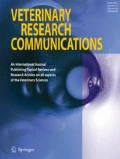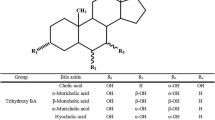Abstract
Serum bile acids were fractionated by high-performance liquid chromatography (HPLC) in 13 control and 8 cases of liver disease in horses. The severity and type of liver injury was determined by histopathological examination of biopsy and/or necropsy specimens. The total serum bile acids (tSBA) were determined in these horses by an enzymatic method (SBA-EA) and by summation of the bile acids (SBA-LC) as fractionated by the HPLC. The SBA-LC were generally higher than the SBA-EA in both the controls and liver disease and they did not parallel each other. The primary bile acids, total cholates and total chenodeoxycholates accounted for most of the tSBA increases in liver disease. There was a shift in profile from taurocholate to free (unconjugated) cholate in direct relation to the severity of the liver injury. Among the secondary bile acids, total deoxycholates and total taurodeoxycholates increased at random. The pattern of the SBA profile in relation to the severity of the liver disease suggested that hepatocellular excretion is the most sensitive step in the enterohepatic circulation of the bile acids.
Similar content being viewed by others
References
Anwer, M.S., Gronwall, R.R., Engelking, L.R. and Klentz, R.D., 1975. Bile acids kinetics and bile acid secretion in the pony.American Journal of Physiology,229, 592–597
Anwer, M.S., Engelking, L.R., Gronwall, R.R. and Klentz, R.D., 1976. Plasma bile acid elevation following CCl4 induced liver damage in dogs, sheep, calves and ponies.Research in Veterinary Science,10, 127–130
Balistreri, W.F. and Shaw, L.M., 1987. Liver function. In: N.W. Tietz (ed.),Fundamentals of Clinical Chemistry, 3rd edn. (W.B. Saunders, Philadelphia), 729–761
Campbell, C.B., McGuffie, C., Powell, L.W., Roberts, R.K. and Stewart, A.W., 1978. Post prandial changes in serum concentration of individual bile salts in normal subjects and patients with acute viral hepatitis.American Journal of Digestive Diseases,23, 599–608
Center, S.A., Baldwin, B.H., Delahunta, A., Dietz, A.E. and Tennant, B.C., 1985. Evaluation of serum bile acid concentration for the diagnosis of portosystemic venous anomalies in the dog and cat.Journal of the American Veterinary Medical Association,186, 1090–1094
Engelking, L.R. and Gronwall, R.R., 1979. Effects of fasting on hepatic bile acid clearance.Proceedings of the Society for Experimental Biology and Medicine,161, 123–127
Frimmer, M. and Ziegler, K., 1988. The transport of bile acids in liver cells.Biochimica et Biophysica Acta,947, 75–99
Goto, J., Saito, M., Chikai, T., Goto, N. and Nambara, T., 1983. Studies on steroids, CLXXXVII. Determination of serum bile acids by high-performance liquid chromatography with fluorescence labelling.Journal of Chromatography,276, 289–300
Hauge, J.G. and Abdelkader, V., 1984. Serum bile acid as an indicator of liver disease in dogs.Acta Veterinaria Scandinavica,25, 495–593
Hoffmann, W.E., Baker, G., Rieser, S. and Dorner, J.L., 1987. Alteration in selected serum biochemical constituents in equids after induced hepatic disease.American Journal of Veterinary Research,48, 1343–1347
Hofmann, A.F., 1988. Bile acids. In: I.W. Arias, W.B. Jakoby, H. Popper, D. Schacter and D.A. Shafritz (eds.),The Liver: Biology and Pathobiology, 2nd edn., (Raven Press, New York), 553–572
Kaplowitz, N. and Kok, E., 1973. Post prandial serum bile acid for the detection of hepatobiliary disease.Journal of the American Medical Association,225, 292–293
Lessard, P., Wilson, W.D., Olander, H.J., Rogers, Q.R. and Mendel, V.E., 1986. Clinicopathologic study of horses surviving pyrrolizidine alkaloid (Senecio vulgaris) toxicosis.American Journal of Veterinary Research,47, 1776–1780
Mayes, P.A., 1988. Cholesterol synthesis, transport and excretion. In: R.K. Murray, D.K. Granner, P.A. Mayeset al. (eds.),Harper's Biochemistry, 21st edn., (Appleton and Lange, Norwalk), 241–252
McGilvery, R.W., 1983. Turnover of fats and lipoproteins: the cholesterol connection. In:Biochemistry. A Functional Approach. 3rd edn., (W.B. Saunders, Philadelphia), 555–571
Mendel, V.E., Witt, M.R., Gitchell, M.S., Gribble, D.N., Rogers, Q.R., Segall, H.J. and Knight, H.D., 1988. Pyrrolizidine alkaloid-induced liver disease in horses: an early diagnosis.American Journal of Veterinary Research,49, 572–578
Parraga, M.E. and Kaneko, J.J., 1985. Total serum bile acid profile as tests of liver function.Veterinary Research Communications,9, 79–88
Thompson, M.B., Blair, P.C., Morris, R.W., Neptun, D.A., Deyo, D.F. and Popp, J.A., 1987. Validation and application of a liquid-chromatographic/enzymatic assay for individual bile acids in the serum of rats.Clinical Chemistry,33, 1856–1862
Vlahcevic, Z.R., Heuman, D.M. and Hylemon, P.B., 1990. Physiology and pathophysiology of enterohepatic circulation. In: D. Zakim and T.P. Boyer (eds.),Hepatology: A Textbook of Liver Disease, (W.B. Saunders, Philadelphia), 341–377
West, H.J., 1989. Evaluation of total plasma bile acid concentration for the diagnosis of hepatobiliary disease in horses.Research in Veterinary Science,46, 264–270
West, H.J., 1991. Evaluation of total serum bile acid concentrations for the diagnosis of hepatobiliary disease in cattle.Research in Veterinary Science,51, 133–140
Whitney, J.O. and Thaler, M.M., 1980. A simple liquid chromatography method for quantitative extraction of hydrophobic compounds from aqueous solution.Journal of Liquid Chromatography,3, 545–556
Author information
Authors and Affiliations
Rights and permissions
About this article
Cite this article
Kaneko, J.J., Rudolph, W.G., Wilson, D.W. et al. Bile acid fractionations by high-performance liquid chromatography in equine liver disease. Vet Res Commun 16, 161–172 (1992). https://doi.org/10.1007/BF01839151
Accepted:
Issue Date:
DOI: https://doi.org/10.1007/BF01839151



